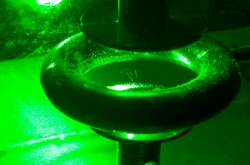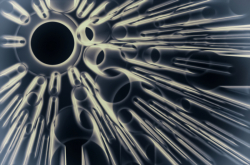Problems to solve
Currently projects for transforming storage and saving energy, related to personal use, are focused on increasing capacity and efficiency of batteries. Systems used by manufacturing enterprises and organizations located in residential areas have to be able to follow cost cutting principles and be resistant to overloads, believes Alexander Atraschenko, engineer at the International Research Center for Nanophotonics and Metamaterials who won a grant for developing his project "The New Generation of Supercapacitors."
Supercapacitors will help replace lithium-ion battery with new ones. The problem of Li-ion batteries is that they discharge very fast because when Li ions go from anode to cathode they do not return to the same crystalline atomic structure, they had before. It leads to a process that when each time it is recharged and discharged, the atoms change the places, and the battery loses its productivity. Furthermore, despite safety measures, lithium-ion batteries may burst due to overheating or short circuit.
According to Mr. Atraschenko, such up-to-date energy-storage technology as a pumped hydroelectric one, assists to reduce costs. Pumped storage units store energy by pumping water into reservoirs. To provide this pumping the system uses another renewable energy source, for example, a windpower generator. There are also other promising systems like mechanical energy storage devices. Thermal energy storage is also affordable — it is related to such projects as solar thermal power systems.
Promising solution № 1: Silicon-air batteries
According to the developers at the Jülich Research Center (Germany) his new battery type has more capacity and weighs less. They stay charged for over a week. Furthermore these batteries are more eco-friendly and resistant to external influence. Silicon is one of the most widespread elements in the world, so producing these batteries is quite cheap. The scientists use silicon anodes. However, silicon’s expansion and compression, caused by interaction with electrolytes, leads to its' destruction. The scientists plan to solve this problem by using something else instead of the anode. However it is not the best solution and that is why researchers from various scientific centers are looking for ways of how to stop degradation of silicon used in batteries.

Reactor prototype using granular fuel in Yulikhskom Research Center
Source: wikimedia.org
Promising solution № 2: biobatteries into a single sheet of paper
Researchers at State University of New York at Binghamton (the USA) used biological mechanisms as the main principle. They used a paper chromatography method — one side of paper was covered with a thin layer of wax and with silver nitrate at the top — this served as a cathode. Another side was covered with a conductive polymer, which became an anode. Then they folded it and added several drops of dirty water that contained bacteria — the liquid served as an electrolyte. The cellular respiration provoked energy production.
Now several million batteries are required to switch on a 40 watt light bulb. However this "paper-based" battery is likely to supply wearable biosensors used for medical purposes. It can be also used when there is no other energy source.
Promising solution № 3: nanowire-based batteries
Thanks to a new nanowire-based technology lithium-ion batteries to be recharged hundreds of thousands of times. According to researchers from University of California, Irvine, this is a step towards a perpetual motion-battery, which will be used in smartphones, computers, cars and jets.
Researchers have been working on an idea for applying nanowires to batteries, as these materials have a good electrical conductivity. However they are very thin and wear-prone. To solve this problem American researchers covered gold nanowires with manganese dioxide and put them into an electrolyte solution. The result was very good — the battery didn’t lose its capacity after being charged 200 thousand times. Previously such batteries stopped working after 5−7 thousand charges.

Source: news.uci.edu
Promising solution № 4: rechargeable zinc-manganese batteries
Zinc-manganese elements are chemical current sources. Their cathodes are manganese dioxides mixed with graphite, electrolytes are ammonium chloride solutions and anodes are zinc metals.
This battery type has been studied for many years because required elements are cheap and widespread. The problem is that such batteries stop working after several charging sessions.
The researchers at Pacific Northwest National Laboratory (the USA) discovered that this problem was caused by uncontrolled chemical reactions, manganese "disappears" in the electrolyte solution. To slow this process down, the researchers added manganese ions to the solution. It resulted in increasing the battery’s activity, as it could be charged 5 thousand times and lose only 8% of its capacity.
Promising solution № 5: energy can be stored by organic molecules
Harvard University’s researchers developed high-capacity batteries that save energy thanks to organic molecules called quinones and food additive called ferrocyanide. The researchers replaced metal ions that were previously used as typical electrolytes, with quinones, that transfer electrons in photosynthetic cells of plants. In 2015 they developed a quinone, which "works" in alkaline environment. The batteries based on this technology, store energy in external tanks: the bigger a tank is the more energy one can store. This development can change the market of energy storage completely, as quinones are non-flammable, non-toxic, non-corrosive, and low-cost.
Promising solution № 6: Elon Musk's Solar Batteries
Most modern research that has to do with high-capacity accumulators involves solar energy. Scientists all over the world research the application of solar battreries for personal and commercial purposes. The "solar roof" by the Tesla Company and SolarCity can well become a serious competitor to the commonly used urban powerlines.
The roof covering provided by these companies is not much different in appearance in comparison with regular roofs. It can be made of any traditional material — tiles, cement slates, glass, etc. — but there will be solar panels fixed into it. The energy will be produced using special transformers.
Solar roofs are not Musk's only project on energy accumulators. The inventor and businessman also produces batteries for his electromobiles.

ITMO’s Achievements
St. Petersburg researchers are working on increasing renewable power sources including solar batteries. ITMO won a megagrant to build a new laboratory for studying these systems.
The researchers at the university also develop colloidal nanocrystals that can be used in solar batteries. Currently such devices are not as effective as they could be, as they don’t absorb infrared light. It is possible to create a specific structure with so-called quantum dots, which would solve this problem.






